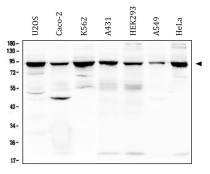ARG43131
anti-RNF169 antibody
anti-RNF169 antibody for Western blot and Human,Mouse,Rat
Overview
| Product Description | Rabbit Polyclonal antibody recognizes RNF169 |
|---|---|
| Tested Reactivity | Hu, Ms, Rat |
| Tested Application | WB |
| Host | Rabbit |
| Clonality | Polyclonal |
| Isotype | IgG |
| Target Name | RNF169 |
| Antigen Species | Human |
| Immunogen | Recombinant protein corresponding to N311-K708 of Human RNF169. |
| Conjugation | Un-conjugated |
| Alternate Names | E3 ubiquitin-protein ligase RNF169; EC 6.3.2.-; RING finger protein 169 |
Application Instructions
| Application Suggestion |
|
||||
|---|---|---|---|---|---|
| Application Note | * The dilutions indicate recommended starting dilutions and the optimal dilutions or concentrations should be determined by the scientist. | ||||
| Observed Size | ~ 90 kDa |
Properties
| Form | Liquid |
|---|---|
| Purification | Immunogen affinity purified. |
| Buffer | 0.2% Na2HPO4, 0.9% NaCl, 0.05% Sodium azide and 4% Trehalose. |
| Preservative | 0.05% Sodium azide |
| Stabilizer | 4% Trehalose |
| Concentration | 0.5 mg/ml |
| Storage Instruction | For continuous use, store undiluted antibody at 2-8°C for up to a week. For long-term storage, aliquot and store at -20°C or below. Storage in frost free freezers is not recommended. Avoid repeated freeze/thaw cycles. Suggest spin the vial prior to opening. The antibody solution should be gently mixed before use. |
| Note | For laboratory research only, not for drug, diagnostic or other use. |
Bioinformation
| Database Links |
Swiss-port # E9Q7F2 Mouse E3 ubiquitin-protein ligase RNF169 Swiss-port # Q8NCN4 Human E3 ubiquitin-protein ligase RNF169 |
|---|---|
| Gene Symbol | RNF169 |
| Gene Full Name | ring finger protein 169 |
| Function | Probable E3 ubiquitin-protein ligase that acts as a negative regulator of double-strand breaks (DSBs) repair following DNA damage. Recruited to DSB repair sites by recognizing and binding ubiquitin catalyzed by RNF168 and competes with TP53BP1 and BRCA1 for association with RNF168-modified chromatin, thereby acting as a negative regulator of DSBs repair. E3 ubiquitin-protein ligase activity is not required for regulation of DSBs repair. [UniProt] |
| Cellular Localization | Nucleus, nucleoplasm. Note=Localizes to sites of double-strand breaks (DSBs) following DNA damage. Recruited to DSBs via recognition of RNF168-dependent ubiquitin products. [UniProt] |
| Calculated MW | 77 kDa |
Images (1) Click the Picture to Zoom In






